History Of Bread: Basic Food Of Man In Ancient And Contemporary Cultures Around The World
A. Sutherland - AncientPages.com - Bread has been known for millennia though its authentic history is lost in time. It is the primary food of man in almost all cultures worldwide.
The folklore surrounding bread was passed down through oral tradition, hieroglyphics found in ancient Babylonia and Egyptian tombs, and old records about bread left by ancient Chinese writers.
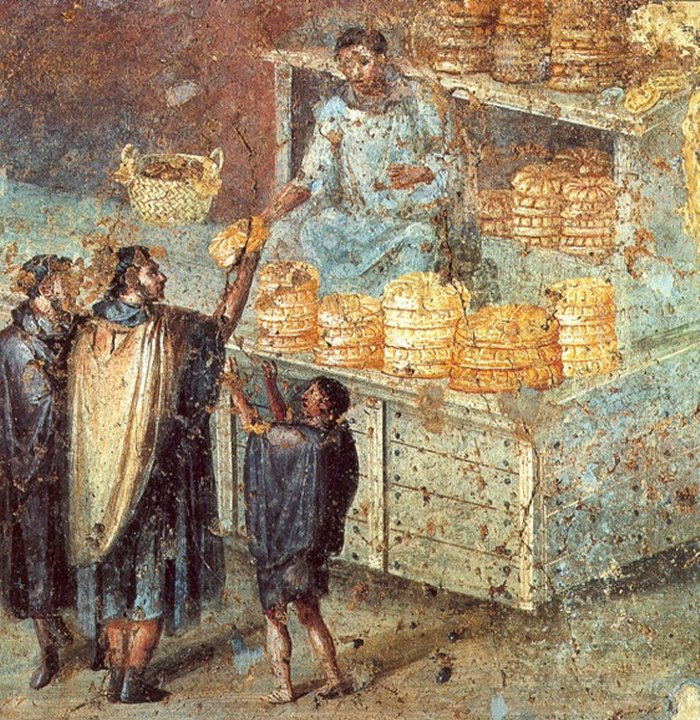 Sale of bread at a market stall. Roman fresco from the Praedia of Julia Felix in Pompeii. source
Sale of bread at a market stall. Roman fresco from the Praedia of Julia Felix in Pompeii. source
Bread played a crucial cultic role (for example, in the Old Testament) as well as cultural and symbolic. Christian tradition has been known as a widespread custom to bless each new loaf of bread with the sign of the Cross. Also, the Sacrament of Communion (flesh and blood, bread and wine) is essential in Christian imagery, symbolizing the blood of Jesus Christ.
In Judaism and Christianity, unleavened bread (prepared without yeast) is also symbolic.
It All Started With Herbs, Fruits, Nuts And Grinding of Grain
At first, people lived on fruits, herbs, and later nuts, which they included in their daily menu. The next step was grinding grain, recorded by early historians of Assyria, India, America, and China. The grain was softened with water (forming a paste) and sundried in thins slabs similar to pancakes (but with a hole in the center of each cake). Then these pancakes were stored for winter and seasons of drought. It was rather primitive baking that satisfied hunger, but it was long before wheat was grown.
This practice (easier to prepare in warm countries) was also popular among the Scottish and Scandinavian people, where the climate did not help make this kind of food.
First, Crude Ovens And Egyptian Bread Baking
The first crude ovens predated Babylonia by approx. 2,000 years. The first ovens consisted of holes in the ground dug to a depth of about four and one-half feet, and they were lined with baked mud. A fire was built over these holes, and the ashes were scraped to place the dough inside. A flat brick covered the top of the oven.
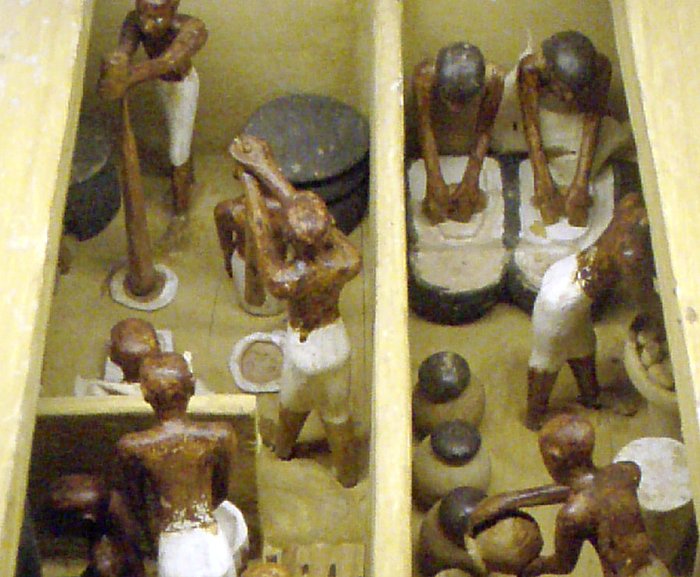 A funerary model of a bakery and brewery, dating the 11th dynasty, circa 2009-1998 B.C. Painted and gessoed wood, originally from Thebes. Source
A funerary model of a bakery and brewery, dating the 11th dynasty, circa 2009-1998 B.C. Painted and gessoed wood, originally from Thebes. Source
The first homemade, conical-shaped bread ovens have their beginnings in ancient Egypt. The baker’s oven was a dome-shaped vault. Egyptian texts mention at least 30 different, widely used, and enjoyed bread products. Baking bread was a well-organized activity in bakeries with large bread ovens.
The bread was a payment in kind for the Egyptians: wages and taxes were calculated in bread loaves. Ancient Egyptians sometimes paid their officials with good bread.
The paintings on the walls of the tombs in ancient Egypt show that baking around the 25th century BC was an art. The Egyptians were the first to introduce yeast directly into their bread. They also found that they could take a piece of dough from one batch and save it for the next day’s batch of dough. It was how the origin of sourdough started and is still used today.
With time, the construction of ovens developed. The first closed arch ovens were built in Rome, and this furnace gradually improved over the centuries.
The real gourmets of bread were the ancient Greeks. In the 3rd century BC, there had over 70 types of bread. The oldest bread that archaeologists managed to unearth comes from Crete (Greece), and its age is estimated at 6100 years. Initially, it was baked in ashes, later, in the first bread oven that was warmed up inside and open at the front.
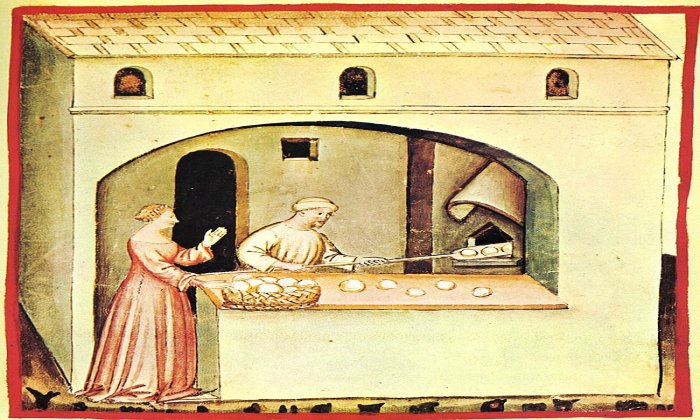 Bread shop, Tacuinum Sanitatis from Northern Italy, beginning of the 15th century. Image credit: Author unknown - Public Domain
Bread shop, Tacuinum Sanitatis from Northern Italy, beginning of the 15th century. Image credit: Author unknown - Public Domain
As early as the fifth century BC, there were over 300 bakeries owned by Greek bakers in Rome.
The Greeks passed on the artistry and the baking techniques to the Romans, who turned baking into a large-scale industry.
The ancient Romans became interested in bread at the turn of the eighth and seventh centuries BC. Bread-baking ovens soon became very popular in ancient Rome, and during the reign of Emperor Octavian Augustus (27 BC – 14 CE), there were about 300 ovens baking bread.
Large bakeries emerged in all Roman cities and had professional bread ovens where large quantities could be baked at once.
Bread Changed Over The Centuries
The appearance and properties of bread have changed significantly over the centuries thanks to significant improvements in baking techniques and various bread ingredients.
The most original form of bread was baked in ashes, on hot stones, grates, and metal sheets. Baking pancakes under a clay pot (bell) covered with hot ash gave rise to dome bakery ovens with a side hole, which in this form survived from Roman times almost to our modern times.
 Machine-made Shmura Matzo, eaten during Passover week. source
Machine-made Shmura Matzo, eaten during Passover week. source
Egyptians Baked Sourdough Bread Almost 4,000 Years Ago
The first documented production of sourdough bread dates back to ca. 1500 BC. Egyptians realized that when flour and water were left out long enough to ferment, the resulting dough increased in volume and could be baked into bread. When they fled the region, the Jewish people learned to make sourdough bread in Egypt and took that knowledge with them.
Then, sourdough bread became popular in Europe and the Middle East.
Bread For Pilgrims, Travelers, The Sick And Poor People
Bread in the early Middle Ages, even pre-Christian times, played a significant role in Europe in local rituals. In the form of a cake called ‘kolacz’ ( a type of pastry of Polish origin), it was an essential element of weddings and traditional ethnic holidays among the Slavs.
Later, medieval bakery art was developed in municipal bakeries and monasteries that had their bakeries producing bread for themselves. In addition, they were required to give bread to travelers, the sick, and the poor. As they owned grain mills, they had bread for pilgrims as well.
Industrial Bread In Portions - Sliced Bread
The one-loaf-at-a-time bread-slicing machine was one Otto Frederick Rohwedder of Davenport, Iowa. He was widely regarded as the inventor of industrial portioned bread. In 1912, Rohwedder patented an automatic bread slicer, but in 1917 a fire broke out at the factory where he was manufacturing his machine. It destroyed his prototype and blueprints.
Not until 16 years later did his machine finally appear on the market. The Chillicothe Baking Co. bought it, and their product called Kleen Maid Sliced Bread made a great success.
Written by – A. Sutherland - AncientPages.com Senior Staff Writer
Updated on June 2, 2023
Copyright © AncientPages.com All rights reserved. This material may not be published, broadcast, rewritten or redistributed in whole or part without the express written permission of AncientPages.com
Expand for referencesReferences:
Ashton J. The History of Bread From Pre-historic to Modern Times
Gobetti M & Gänzle M. Handbook on Sourdough Biotechnology,
Jacob H. E. Six Thousand Years of Bread
More From Ancient Pages
-
 Mystery How Humans Lost Their Body Hair Solved By Scientists
Archaeology | Jan 4, 2023
Mystery How Humans Lost Their Body Hair Solved By Scientists
Archaeology | Jan 4, 2023 -
 On This Day In History: Viking Forces Laid Siege To Paris – On Nov 25, 885
News | Nov 25, 2016
On This Day In History: Viking Forces Laid Siege To Paris – On Nov 25, 885
News | Nov 25, 2016 -
 Huge Ancient Underwater Structure And Stunning Artifacts Discovered Off The Coast Of Salamis
Archaeology | Jun 26, 2019
Huge Ancient Underwater Structure And Stunning Artifacts Discovered Off The Coast Of Salamis
Archaeology | Jun 26, 2019 -
 Viking Sword Unearthed In Grave Excavated by Archaeologists In Central Norway
Archaeology | Aug 27, 2020
Viking Sword Unearthed In Grave Excavated by Archaeologists In Central Norway
Archaeology | Aug 27, 2020 -
 Secret Hidden Freemasonic Messages Concealed In Ancient Egyptian Artifacts And Roman Works – A Misunderstood Object? – Part 1
Featured Stories | Feb 18, 2022
Secret Hidden Freemasonic Messages Concealed In Ancient Egyptian Artifacts And Roman Works – A Misunderstood Object? – Part 1
Featured Stories | Feb 18, 2022 -
 Crannogs – Artificial Islands In Scotland Are Older Than Stonehenge
Archaeology | Jun 17, 2019
Crannogs – Artificial Islands In Scotland Are Older Than Stonehenge
Archaeology | Jun 17, 2019 -
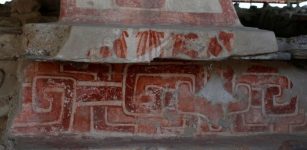 Teotihuacan’s Puzzling Red Glyphs Could Be Unknown Ancient Writing
Archaeology | Sep 22, 2020
Teotihuacan’s Puzzling Red Glyphs Could Be Unknown Ancient Writing
Archaeology | Sep 22, 2020 -
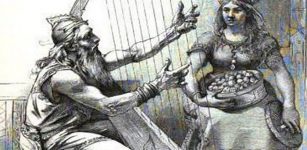 Bragi – Norse God Of Poetry, Eloquence, Music And Singing And Husband To Idun Who Protected Golden Apples
Featured Stories | Mar 17, 2018
Bragi – Norse God Of Poetry, Eloquence, Music And Singing And Husband To Idun Who Protected Golden Apples
Featured Stories | Mar 17, 2018 -
 Mysterious Watson Brake: Old Mound Complex In North America With Earthworks Raised For Unknown Purpose
Civilizations | Feb 21, 2018
Mysterious Watson Brake: Old Mound Complex In North America With Earthworks Raised For Unknown Purpose
Civilizations | Feb 21, 2018 -
 On This Day In History: Columbus Reached Honduras With His Ships – On July 30, 1502
News | Jul 30, 2016
On This Day In History: Columbus Reached Honduras With His Ships – On July 30, 1502
News | Jul 30, 2016 -
 Ancient DNA Reveals “Completely Unexpected” Marriage Rules In Minoan Crete
Archaeology | Jan 16, 2023
Ancient DNA Reveals “Completely Unexpected” Marriage Rules In Minoan Crete
Archaeology | Jan 16, 2023 -
 More Than 2,500 Years Old Gallic Tombs Unearthed In Nîmes, Southern France
Archaeology | Aug 17, 2020
More Than 2,500 Years Old Gallic Tombs Unearthed In Nîmes, Southern France
Archaeology | Aug 17, 2020 -
 First Carbon-Based Paleolithic Paintings Found In Font-De-Gaume Cave, France Could Be 19,000 Years Old
Archaeology | Dec 29, 2023
First Carbon-Based Paleolithic Paintings Found In Font-De-Gaume Cave, France Could Be 19,000 Years Old
Archaeology | Dec 29, 2023 -
 Ancus Marcius: Semi-Legendary Fourth King Of Rome Obliged To Make War To Defend And Expend Territories
Featured Stories | Jul 12, 2019
Ancus Marcius: Semi-Legendary Fourth King Of Rome Obliged To Make War To Defend And Expend Territories
Featured Stories | Jul 12, 2019 -
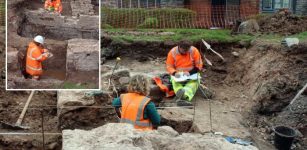 Medieval Manor Of Court De Wyck – Re-Discovered
Archaeology | Oct 10, 2023
Medieval Manor Of Court De Wyck – Re-Discovered
Archaeology | Oct 10, 2023 -
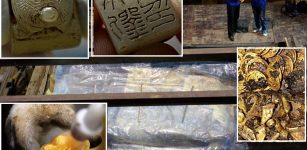 Mystery Of Marquis of Haihun: 2,000-Year-Old Royal Coffin Opened In China
Archaeology | Apr 20, 2016
Mystery Of Marquis of Haihun: 2,000-Year-Old Royal Coffin Opened In China
Archaeology | Apr 20, 2016 -
 Gorgo – Queen Of Sparta And Wife Of King Leonidas Broke A Secret Code And Stopped An Invasion
Featured Stories | Aug 5, 2019
Gorgo – Queen Of Sparta And Wife Of King Leonidas Broke A Secret Code And Stopped An Invasion
Featured Stories | Aug 5, 2019 -
 On This Day In History: Pueblo Indians Capture Santa Fe From The Spanish – On August 21, 1680
News | Aug 21, 2016
On This Day In History: Pueblo Indians Capture Santa Fe From The Spanish – On August 21, 1680
News | Aug 21, 2016 -
 Dinosaurs Were On The Up Before Asteroid Downfall – Study Finds
Archaeology | Dec 8, 2022
Dinosaurs Were On The Up Before Asteroid Downfall – Study Finds
Archaeology | Dec 8, 2022 -
 Unas (Unis): First Pharaoh Who Decorated His Burial Chamber With Pyramid Texts
Featured Stories | Jun 3, 2021
Unas (Unis): First Pharaoh Who Decorated His Burial Chamber With Pyramid Texts
Featured Stories | Jun 3, 2021
